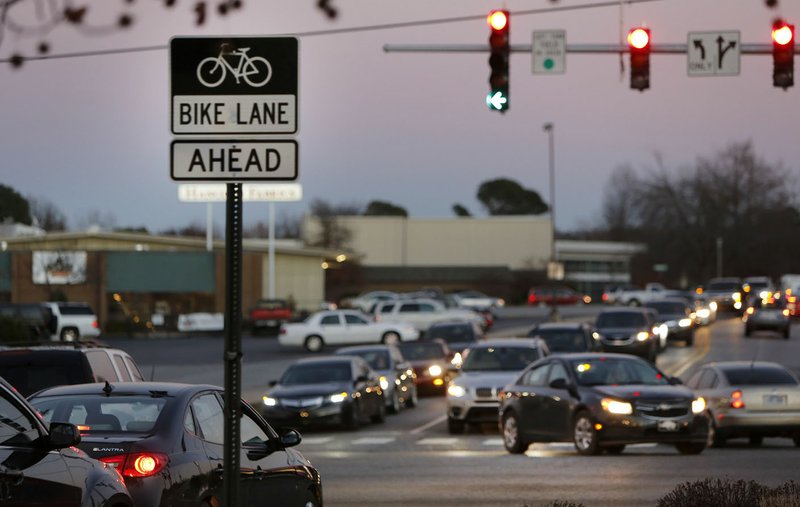The automobile is still king of the road in Northwest Arkansas, rolling through the vast majority of state and federal money dedicated to transportation improvements.
The situation isn't likely to change given the lack of options, lack of money and pull of tradition, experts said.
Two ways to avoid the daily Interstate 49 fray is to stay home or schedule office hours to avoid morning and afternoon rush hours.
The advent of laptops, cellphones and wi-fi hotspots has made working from home or remote locations viable options. Every little bit helps in diverting traffic and in spreading out traffic on the same infrastructure into different times of the day, said David Schrank, a researcher for the Texas A&M Transportation Institute.
Daniel Martin, a software designer who lives in Fayetteville, works for a company based in Massachusetts with a satellite office in Bentonville and sometimes works from the cab of his pickup on the family farm near Pettigrew in Madison County.
"I'm spread out over three counties, so I telecommute whenever possible to avoid going up and down I-49," Martin said.
Martin admitted his experience may not be typical.
"I work as a software developer, so the office fits into a laptop and an iPhone," he said. "For this company, telecommuting is the norm."
Telecommuting is unusual in Northwest Arkansas, U.S. Census Bureau figures show. The percentage of people spending at least one day out of the workweek working at home in the Fayetteville-Springdale-Rogers Metropolitan Area was 3.4 percent in 2010. The figure is barely an increase, percentage-wise, from 2000 and has been on the decline since 2005.
The national average in 2010 was 9.5 percent, bureau figures show.
Some Northwest Arkansas employers, including Walmart, Tyson Foods and Northwest Arkansas Community College, offer selected employees options such as flexible hours, which allow workers to come in later or earlier, compressed work weeks in which workers can turn in 40 hours in less than five working days and telecommuting.
Worth Sparkman, a spokesman at Tyson, said the company has some employees who work from home and some who have flexible schedules for office hours.
"Decisions about these working arrangements are typically left up to their manager," he said in an email.
Steven Hinds, executive director of public relations and marketing at the community college, said flexible schedules are customer service driven.
"There are some employees who work flex schedules in order to accommodate our extended hours since we have students and potential students who may need to access certain offices after 4:30 pm.," he said. "For example, our office of admissions and advising is open until 6 p.m. Monday through Thursday."
Many self-employed people work from home, according to national figures from the Census Bureau.
"The reality is that there are only so many types of jobs that can be done from home," Schrank said. "Retail employees have to go to their complexes, and doctors have to see patients.
"There's a lot of buy-in for employers because you have to buy your employees laptops, for example. The biggest thing, though, is that it's going to take a lot of pressure to change."
Much of the pressure to change is coming from prospective employees.
"The younger, tech-savvy generation is asking, 'Why do I have to come into the office every day?'" he said.
WalletHub, an online social network, estimates U.S. workers could save more than $900 billion a year and prevent some 3.6 million tons of greenhouse gas emissions if more people were allowed to work from home.
Hop on the Bus, Gus
Public transit using buses is the most obvious and visible alternative to driving in Northwest Arkansas, whether on Ozark Regional Transit or its sister service at the University of Arkansas Razorback Transit.
Joel Gardner, executive director at ORT, said the region cannot build its way out of traffic congestion problems by adding more and more lanes to I-49 and other roads.
"There's only so far on a road we can go before we eat the sidewalk and the front porch," Gardner said. "We can only go so wide. So how do we grow and expand wisely?"
Planners predict 800,000 people will live in the metropolitan area by 2040. Gardner said public transit is one way to reduce traffic congestion and accidents.
"It's my hope that we will be able to get ourselves to a point where we're an alternative to using cars through our park-and-ride programs along the I-49 corridor," Gardner said. ORT has several park-and-ride locations in operation.
Gardner said ORT's route between the University of Arkansas in Fayetteville and Northwest Arkansas Community College in Bentonville moves about 30,000 people a year. The "express" service is hourly and free for NWACC students.
Razorback Transit runs routes primarily around the university campus but also has several routes through Fayetteville. The system provided just more than 2 million rides last year and is on track to do the same this year, according to Gary Smith, transit director. Razorback Transit has a budget of about $4.5 million a year.
Regional Transit provides some 320,000 individual trips a year, according to Gardner. The public transit provider has a total annual budget of about $3.6 million.
ORT and Razorback Transit are expected to share $704,000 in federal Surface Transportation Program money for new, replacement vehicles next year.
Ozark Regional Transit most recently added what officials call "workforce" routes, in partnership with large employers, to get employees to various poultry plants in Springdale and Rogers. George's in Springdale is paying more than $9,000 a month, which pays for the route, Gardner said. Other routes are in demonstration mode or being developed.
The transit system has four routes in Fayetteville, four in Springdale, three in Rogers and one in Bentonville. There's also a route between West Fork and Lincoln that runs on 90-minute intervals.
"We now need to determine how to effectively reach and educate individual groups within the community so they can understand the cost-effectiveness of public transportation," Gardner said.
Gardner would eventually like to see buses leaving each end of the Bentonville-to-Fayetteville corridor in 15- to 20-minute intervals with regular stops along the way. Buses now run hourly when NWACC is in session and every two hours when school is out.
"That would make a significant impact on the traffic that's on the I-49 corridor," he said.
Gardner said people will still need to be moved around within the various cities once they arrive on local routes.
Just Drop Off the Key Lee
The jewel of the region's alternative transportation system is the Razorback Greenway. The paved multiuse trail stretches 36 miles from south Fayetteville north to Bella Vista. The cost to build the greenway, which was completed in May, was about $38 million.
Most of the money for the greenway and other trail projects came from private donations. Planners included a transportation element to the project in their applications for federal money, and people use the system for more than exercise and recreation, said John McLarty of the Northwest Arkansas Regional Planning Commission.
"Our specific application had a strong emphasis on the trail being a transportation/commuting corridor linking schools, retail, jobs and etc.," McLarty said.
Regional planning has been working with Alta Planning+Design, which designed the greenway, and the cities to track trail usage, not just in numbers but in purpose.
A recent study by Alta shows some areas along the greenway average more than 800 pedestrians and more than 700 cyclists each day. The busiest areas were downtown Fayetteville and Bentonville for pedestrians and north Fayetteville for cyclists, according to a map that accompanied the study.
Roughly 150,000 people live or work within half a mile of the greenway. Still, the study found the vast majority of trail use in Northwest Arkansas is for recreation.
Northwest Arkansas' urban corridor had about 30 miles of paved trails in 2010, now there's more than 100 miles, according to Misty Murphy, former Trails Coordinator for the Northwest Arkansas Council. In addition, some 150 miles of soft surface trails are or will be connected to the greenway.
State highway officials are updating the Arkansas Statewide Bicycle and Pedestrian Transportation Plan but say there's little money available to spend on a statewide network for bicycle and pedestrian transportation.
Three federal programs -- the Transportation Enhancements Program, Recreational Trails Program and Safe Routes to School Program -- have been combined into what is now called the Transportation Alternatives Program. Eighty percent of the money for the program will come from the federal government.
West Fork and Prairie Grove recently received Safe Routes to School money. West Fork will get about $95,000 and Prairie Grove about $77,000.
Bentonville and Fayetteville have been awarded Recreational Trails Program money. Bentonville will get $75,000 for its Community Center Fitness Trail. Fayetteville will receive $56,000 for its Lake Fayetteville Natural Trail boardwalk and realignment project.
The region is getting about $480,000 in federal Surface Transportation Program money, which is being dedicated to trail and alternative transportation projects in cities next year.
Rogers is expected to get $225,000 for a bike and pedestrian bridge on the Razorback Greenway at New Hope Road. The remainder of the money is expected to go to Springdale for Dean's Trail, phase I, which would connect the Jones Center with the city's trail system and the greenway.
A Ride on the Rails
Regional planners received a study last year that shows while commuter light rail could work in the Northwest Arkansas corridor, finding the money to pay for the project will likely keep it idle on a siding.
The study, a prerequisite for federal assistance, was paid for with a $200,000 grant from the Federal Transit Administration. It examined two options for rail: light rail on a new right of way roughly parallel to Interstate 49 from Greenland to Bella Vista, and rail using the existing Arkansas & Missouri Railroad right of way wherever possible. The southern terminus would be in Greenland, but the rail line departs from the corridor south of Bentonville and would require a connector of some sort to serve Bentonville and Bella Vista.
Light rail in a new right of way along I-49 would be the most expensive of the alternatives, according to Keith Jones, an engineer and vice president of URS Corp., the consulting firm that did the study. The estimated cost of building a route in the I-49 corridor would exceed the total cost for all the projects in the region's 2035 Long Range Transportation Plan combined.
"A separate light rail is very expensive just because it's really no different than building a multilane highway. You've gotta buy right of way and every parcel has to be dealt with and you've gotta relocate businesses, relocate residential folks, all that kind of stuff," Jones said.
"I think it would be $2.2 or $2.3 billion for the capital costs of building a separate light rail line. That's sort of the big thing to swallow."
Building and operating a light rail network using the existing Arkansas & Missouri right of way is estimated to cost about $693 million.
J. Reilly McCarren, majority shareholder and chairman of the board of the Arkansas & Missouri, said he's open to talking about the possibility of using or sharing the right of way.
A light rail project is also not likely to qualify for federal money. Population densities in the region and estimated ridership are probably not enough to generate the projected ridership numbers required to qualify, according to Jones.
NW News on 12/30/2015


